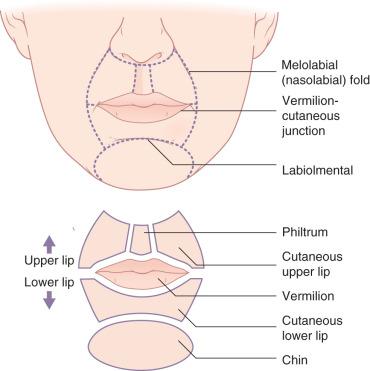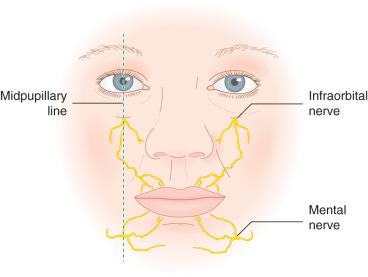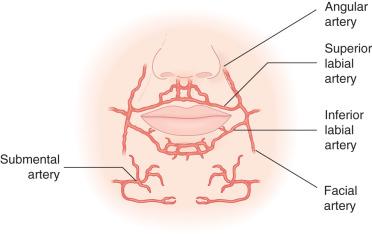Physical Address
304 North Cardinal St.
Dorchester Center, MA 02124
Skin cancer frequently occurs on and around the lips, and repairs of perioral surgical defects present numerous unique reconstructive challenges. Asymmetries and visible scars in the centrofacial region are distracting to onlookers, reduce levels of perceived attractiveness, and can create profound psychosocial stigma. In addition to its highly aesthetic positioning, the lip is a mobile subunit that contributes to speaking, facial expressions, mastication, and oral competence. Its sensory capabilities also allow for it to examine the qualities and temperature of food prior to eating. Successful reconstructive efforts recapitulate natural perioral anatomy, hide incisions discreetly, and fully restore function and sensation. As with other anatomic sites, thoughtful surgical planning and meticulous execution facilitate desirable outcomes. Small perioral defects are repaired in a single stage but can sometimes take many weeks for patients to return to their “baseline” appearance and functioning. Larger lip defects may be exquisitely difficult to repair in a single stage and patients should be counseled that certain repairs sometimes benefit from revision or staging to achieve optimal cosmesis and functioning.
The lips are prominently positioned in the lower central face, bounded by the nose above, cheeks laterally, and chin below. Adult lips are approximately 7 to 8 cm long with 4 to 5 cm between commissures in repose. The upper lip lies slightly anterior to the lower lip and is approximately half the height of the lower lip and chin. Similar to the nose and eyelids, the lips are a trilaminar structure with multiple delicately shaped subunits. From superficial to deep, skin covers a concentrically oriented muscle that is lined posteriorly by buccal mucosa. The bulk of the lip is formed by the orbicularis oris muscle, which consists of four independent quadrants that arise from the modiolus. Each quadrant contains a larger pars peripheralis and a smaller pars marginalis, with the two divisions meeting along the vermilion cutaneous junction (VCJ) to create the bulge of the white roll. Rather than a single collection of encircled muscular fibers, the lip should be considered a collection of eight unique muscular segments that work together for dynamic movement.
The cutaneous skin of the lips is similar in thickness and composition to other centrofacial skin such as the forehead. In men, the terminal hair follicles produce a porous texture, while women have smoother cutaneous skin. Since the orbicularis muscle directly inserts into the undersurface of the perioral skin, dynamic muscular movement creates circumferential radial lines around the lips that are accentuated with pursing. These lines are ideal to hide incisions when reconstructing the lip. Sun damage and chronic smoking ultimately leave these lines etched into the skin and visible at rest.
The perioral region can be divided into five distinct subunits: two upper cutaneous subunits, philtrum, lower lip/chin, and vermilion lip ( Fig. 16.1 ). The upper lip has paired lateral cutaneous subunits that begin laterally at the melolabial fold and end medially at the philtral column. Each superolateral portion of these subunits has a small triangular portion of skin adjacent to the ala that is distinctly lip skin and not cheek or alar skin; these concave apical triangles favor heavily into reconstructive designs and must be preserved for optimal cosmetic outcomes. The philtrum is the medial concave subunit of the upper lip, and it is bounded by the convex philtral columns laterally, the columella superiorly, and the Cupid's bow of the vermilion lip inferiorly.

The lower lip and chin are considered a single aesthetic subunit, and similar to the upper cutaneous subunits, the skin is approximately 8 to 9 mm thick and tethered to the underlying musculature. Of the two lips, the lower lip plays the greater role in oral competence by functioning as barrier to retain intraoral contents such as saliva.
Upper and lower lip skin transitions to specialized mucosa at the VCJ, where there is a marked change in native skin color to a pink–red hue due the thin, nonkeratinizing epithelium and abundant vascularity beneath. The vermilion mucosa is a distinct subunit devoid of salivary glands, and a coronal plane divides it into two components: an internal wet portion and an external dry portion, analogous to the gray line division of the eyelid. The transition from vermilion to cutaneous lip is seamless and forms an ideal location where incisions may be hidden.
The muscles of facial expression attach radially along the outer margin of the orbicularis muscle in bilaterally paired sets to allow for dynamic facial animation and function. These lip elevators and depressors are innervated by the zygomatic, buccal, and marginal mandibular segments of the facial nerve. Many of these muscular fibers intersect at the modiolus, a tissue thickening that can be palpated 1.5 cm lateral to the commissure. The modiolus contributes to dimple formation and can be used as a point of fixation for certain flaps. Sensation to the upper lip is provided by the infraorbital nerve and sensation to the lower lip is provided by the mental nerve ( Fig. 16.2 ).

The blood supply to the perioral region is supplied by the facial artery, which is consistently identified in its corkscrew configuration crossing the border of the mandible at the anterior edge of the masseter muscle. As the artery crosses over the buccinator muscle, it runs underneath the depressor anguli oris and orbicularis oris muscles, where it gives off the inferior and superior labial arteries in succession. The labial arteries originate approximately 10 to 12 mm from the oral commissures to encircle the mouth by running within the salivary glands or buccal side of the orbicularis oris muscle. At the lateral portions of the lip, the labial arteries are approximately 10 mm apart from the lip margin then run closer to the surface as they progress medially. Additional arteries that perfuse the central lip include the columellar and septal perforators that arise from the superior labial artery and the mental artery that perfuses the chin and lower lip ( Fig. 16.3 ).

Perioral reconstruction, similar to other highly mobile and aesthetic facial units such as the eyelids, can be equal parts challenging, humbling, and rewarding. Algorithms for perioral reconstruction abound and may be a useful means early in one's career to develop a conceptual framework. However, each patient's face is unique and each patient's aesthetic goals may vary. When embarking on lip reconstruction three fundamental pieces of information allow for development of an appropriate reconstructive plan:
Where upon the lip is the defect located?
Defects spanning more than one cosmetic subunit require more attention and effort than defects contained within a single subunit.
Upper lip defects have different reservoirs of skin for reconstruction than lower lip defects.
Philtral reconstruction is often more challenging than lower lip reconstruction.
What is the size and shape of the defect?
The width of the lip that the defect spans is often the main determinant of repair type.
The percentage of lip missing is a helpful guide for repair selection, but each patient's skin laxity must be tested so as to avoid incisional tension or iatrogenic microstomia.
Because of natural relaxed skin tension lines (RSTLs), defects that are greater in the vertical dimension are often less challenging to repair than defects that are greater in the horizontal dimension.
What is the defect depth?
Dermatologic surgeons most frequently encounter partial-thickness lip defects that extend to the orbicularis muscle. When located on nonvermilion lip, these always benefit from suturing.
Thin defects on mucosa granulate well.
Full-thickness defects through muscle and mucosa require reapproximation of all three layers of tissue.
Three goals of perioral reconstruction:
Maintain oral competence; preserve mobility and sensation; maximize cosmesis
Second intention works well for superficial vermilion defects.
Incisions heal well when placed in relaxed skin tension lines (RSTLs) and within or parallel to aesthetic subunit boundaries.
Oblique scars and skin grafts on the cutaneous lip are often conspicuous.
The vermilion cutaneous junction (VCJ) is best marked with indelible ink or a scalpel before anesthetizing.
Minimize swelling of local anesthesia by utilizing nerve blocks.
Recruitment of skin for flaps is lateral to medial.
Scar inversion is a greater risk in men because of a dense supply of folliculosebaceous structures.
Muscular activity of the orbicularis oris increases likelihood of scar inversion and patients should be counseled to avoid opening their mouth widely in the postoperative period.
Revisions may be necessary to achieve optimal results, especially for larger, composite defects.
Become a Clinical Tree membership for Full access and enjoy Unlimited articles
If you are a member. Log in here